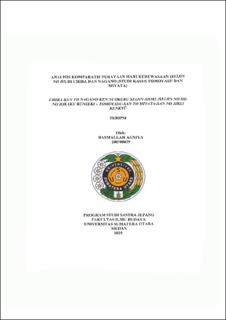| dc.description.abstract | This thesis presents a comparative analysis of the ‘Coming-of-Age’ Day (Seijin No Hi) in Chiba and Nagano: A Case Study of Tomoyasu and Miyata employing cultural, psychological, and comparative theoretical approaches. The research aims to explore the life transitions experienced by both individuals, before and after the ceremony. Employing a qualitative methodology, the research involved in-depth interviews with both indivuals who participated in the celebrations to address the core research questions. The data were analyzed using a descriptive qualitative approach. The analysis identified eight major differences and six notable similarities in how Seijin No Hi is celebrated between the two individuals. Differences were observed in various aspects, including the location of the ceremony, family activities, types of food served, gifts received, and expectations regarding careers and future life paths. However, both individuals shared similar symbolic practices, such as wearing formal attire and consuming alcohol to mark the transition into adulthood. These findings suggest that Seijin No Hi serves as a symbolic passage from adolescence to adulthood, highlighting values such as independence, social responsibility, and civic contribution. Despite variations in ceremonial practices, both individuals' celebrations reflect a shared cultural understanding of adulthood. Furthermore, the study highlights how personal perceptions of maturity are deeply shaped by cultural background and individual life experiences. | en_US |


